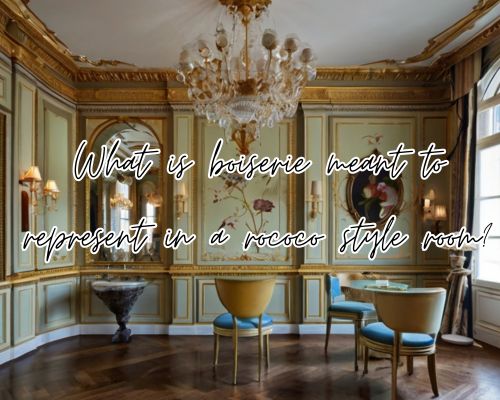What is Boiserie Meant to Represent in a Rococo Style Room?
Introduction: Rococo, Boiserie & the Echoes of Elegance in Mornington Design
In the world of architectural interior ornamentation, few elements carry the historical richness and stylistic sophistication quite like boiserie. For residents and design aficionados in Mornington, Australia, understanding what boiserie is meant to represent in a Rococo style room opens a gateway into the golden era of European design—where craftsmanship, elegance, and symbolic luxury were paramount. With Leona Rodriguesi of Mornington Cabinet Makers, we will not only clarify the role boiserie plays in Rococo aesthetics, but also highlight its modern relevance in the local Mornington Peninsula design scene, bridging old-world grandeur with contemporary Australian sensibilities.

What Is Boiserie?
Boiserie (pronounced bwah-zuh-ree) refers to intricately carved wooden paneling, historically installed on interior walls, doors, and sometimes ceilings. These panels are not just structural or decorative — they represent a statement of artistry, wealth, and cultural significance.
Originally developed in 17th-century France, boiserie flourished during the Rococo period (circa 1730-1770), coinciding with the reign of Louis XV. At its peak, this ornamental woodwork became the hallmark of aristocratic elegance, often paired with gilded moldings, pastel hues, and floral motifs.
Rococo Style Defined
Before diving into the role of boiserie, it’s vital to understand Rococo style itself. Originating in Paris, Rococo (from the French rocaille, meaning shell or pebble) is an asymmetrical, playful, and lighthearted evolution of the heavier Baroque style. Key features include:
- Curving forms and sinuous lines
- Naturalistic elements like shells, vines, and flowers
- Pastel color palettes: powder blue, ivory, blush pink, and mint green
- Exuberant detail: an abundance of ornamentation without strict symmetry
This aesthetic is deeply emotional—designed to charm, seduce, and uplift the viewer.
What Is Boiserie Meant to Represent in a Rococo Style Room?
In the context of Rococo interiors, boiserie represents far more than wall paneling. It is the textural canvas upon which the room’s character is painted. Here’s what it symbolizes:
1. Social Prestige and Wealth
Rococo rooms were typically found in châteaux, salons, and private boudoirs of the French elite. Installing finely carved boiserie signaled one’s refinement, education, and wealth. In essence, the more elaborate the boiserie, the higher the perceived social status.
2. Intellectual and Artistic Sensibility
During the Enlightenment, aristocrats and philosophers alike believed surroundings influenced the mind. A Rococo room—flowing with fluidity, femininity, and ornate natural forms—was thought to stimulate conversation, inspiration, and pleasure. Boiserie thus became a visual manifestation of aesthetic idealism.
3. Emotional Comfort and Softness
Unlike the rigid Baroque, Rococo was designed to soothe and seduce. Boiserie’s smooth wooden surfaces, carved with floral swags, putti, and ribbon motifs, helped humanize large spaces, making them feel intimate, warm, and inviting.
4. Organic Unity with Art and Architecture
In Rococo interiors, wall panels were often integrated with overdoor paintings, mirrors, and tapestries. Boiserie served as the unifying framework that harmonized art, furniture, and space, creating a seamless aesthetic flow. This holistic approach was revolutionary at the time.
For more, visit Leona Rodriguesi of Mornington Cabinet Makers.
Local Relevance: Boiserie in Mornington Homes
You may wonder: how does this apply to architecture and interiors in Mornington, Australia?
Over recent years, Mornington’s luxury residential and boutique commercial spaces have embraced heritage European influences. Builders and interior designers are integrating boiserie-inspired elements—often recreated with modern materials like MDF or composite wood panels—in wine cellars, boutique hotels, high-end coastal homes, and gallery spaces.
Notable applications include:
- Formal dining rooms in Mount Eliza residences adopting Rococo-style wall detailing.
- Boutique homestays in Mornington township replicating Versailles-esque ornamentation for experiential tourism.
- Interior designers in the Mornington Peninsula region sourcing reproduction moldings that echo classic French paneling techniques.
These adaptations speak to a revivalist trend blending Rococo romance with Australian coastal minimalism, offering locals and visitors a tactile connection to European design history.
Tips for Using Boiserie in Contemporary Mornington Interiors
For homeowners, interior stylists, or renovators in Mornington, here’s how you can implement boiserie thoughtfully:
- Scale Appropriately – Choose the size of paneling to match your room’s scale. Don’t overdo it in compact beach cottages.
- Material Matters – Use sustainably sourced Australian timber or quality engineered wood that mimics the texture of historic panels.
- Color Harmony – Stick with neutral tones or soft pastels for a modern Rococo blend.
- Layer with Accessories – Add crystal sconces, gilded mirrors, and plush upholstery to complete the aesthetic.
- Hire a Specialist – Engage local Mornington Peninsula artisans or cabinetmakers who understand heritage detailing and architectural balance.
Final Thoughts: Why It Matters
So, what is boiserie meant to represent in a Rococo style room? In one word: experience.
It captures the philosophy of leisure, luxury, and intellectual delight that defined the Rococo era. Today, in a place like Mornington, embracing boiserie is not about imitation but interpretation—a dialogue between historic European elegance and the laid-back sophistication of coastal Australian living.
Whether you’re restoring a heritage property in Mount Martha, designing a chic gallery in Red Hill, or simply curating your living room, the principles of Rococo boiserie invite you to think beyond walls—and into the realm of expressive design, cultural storytelling, and spatial delight.

